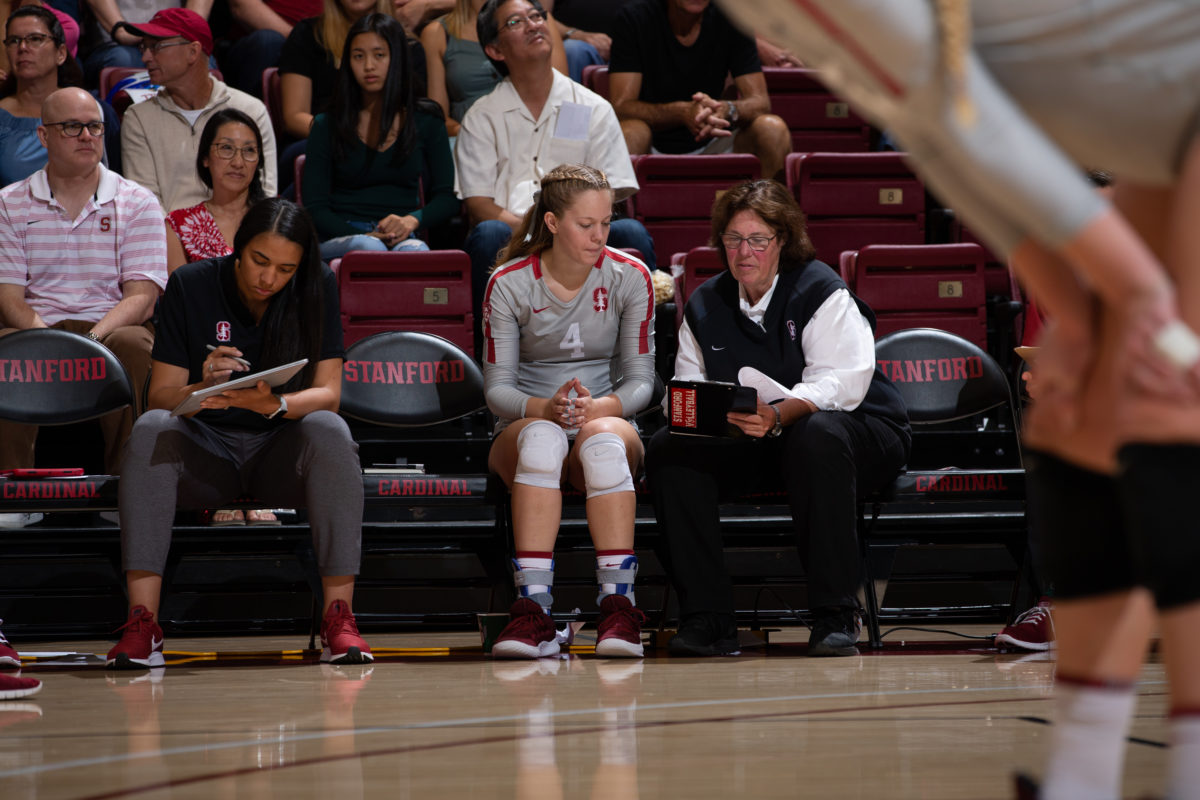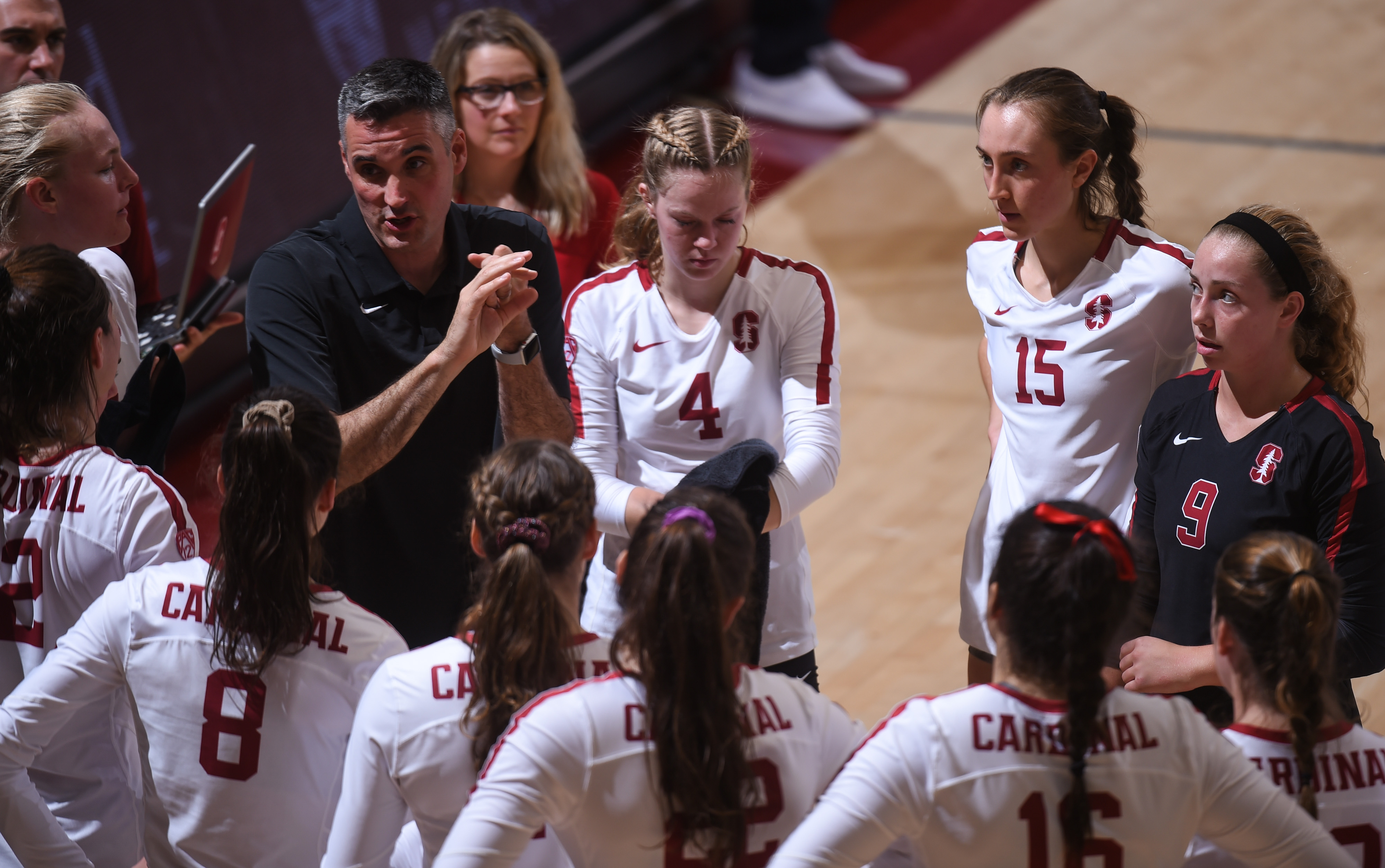An intense debate has broken out in the women’s volleyball team’s locker room. The question is whether the numbered dial on the toaster corresponds to the toasting time (in minutes) or some enigmatic level of toastiness. It’s just before 9 a.m. on a Saturday at Maples Pavilion, and entering stragglers bundled in layers of athletic sweats tip the scales in favor of the toastiness contingent. The bagels spring back up, and the distraction means an official verdict is never reached. Each player finds a spot on a couch or the floor, and the conversations turn from toasters to Oregon.
The previous night, Stanford took care of Oregon State in three sets, and they aim to do the same for the Sunday matinee. They don’t know it yet, but they will achieve that goal in dominating fashion. Thirteen blocks, including nine from graduate middle Madeleine Gates, will hold the Ducks to a season-low .102 hitting percentage. Oregon’s star middle Ronika Stone will be kept in check by junior outside hitter Meghan McClure for two sets before the Ducks are forced to change their rotations. The Cardinal offense will cruise to a .293 hitting efficiency as the middles combine for 13 kills and a single error — a product of the team’s clean passing.
Like most of Stanford’s wins, the victory can be chalked up to physical dominance or an imbalance of skill. But what many spectators will never realize is that the Oregon team had been dissected and its contents laid bare in an early-morning, bagel-laden meeting the day prior.
At 9 a.m., head coach Kevin Hambly and his coaching staff enter the room with laptops, notebooks and even handouts. The team is divided into small groups, each of which is assigned an opposing player to scout. They’ve all done their homework, and they can each break down any of Oregon’s attackers.
Because of the team’s regular Friday-Sunday match schedule, the players generally watch film the day before the scout meeting. Any further out and the film either interferes with preparations for another opponent, or it gets forgotten among school work.
All players and coaches have access to Volleymetrics, a database that holds all the film of every match that every NCAA team has played. Furthermore, the match film can be broken up to show just the service aces, or blocks, or any other type of point.
For most players, the most useful film to watch is of the opponent’s most recent match. Especially in the Pac-12 this year, injuries are prevalent, and rosters change week-to-week. Any upsets or big matches also warrant a view. Finally, if a game is a rematch — like this Oregon match — players will rewatch the previous head-to-head.
The groups quickly compare notes as the staff gets settled, and then a PowerPoint is thrown on the screen. Class is in session.
The presentation contains almost a week’s worth of research, boiled down to 90 or so slides. Exactly one team meeting is devoted to scouting out each match. The vast majority of the work is done before everyone arrives to the locker room for “team scout.”
As head coach, Hambly feels it is his responsibility to have a high-level feel of the opposition. He will be managing the match, and he wants to know in what situations they tend to excel versus when they fall apart. For a new opponent, Hambly watches 10 to 12 matches, eight minimum. For Oregon, he instead watches everything from the two teams’ first meeting onward. Each week is devoted solely to the two upcoming opponents.
“I really just focus on the two teams and just kind of grind out the two teams,” he explained. “I think going too far ahead is pretty difficult for me. I’d rather cram it in in a short time than try to spread it out.”
The division of responsibilities between the coaches means that they each focus on a different aspect of the opponents. Associate head coach Denise Corlett keeps track of all the rotations the opponents use. She watches things such as who gets the ball the most in each rotation and what types of sets are most often used. Assistant coach Alisha Glass Childress scouts the block and the defense, while volunteer assistant coach Russell Corbelli keys on serving, passing and hitter tendencies.

All three coaches use a classic volleyball technique called charting to keep track of the information. Mini volleyball courts are printed on sheets of paper, and each court is used to represent a specific situation. Dots represent players, and colored lines are drawn from a specific dot to represent that player’s hitting, serving or setting preferences. Other charts keep track of defensive trends and adjustments.
Since the data is on paper, charting can be done far in advance. There is no breakpoint the coaches wait for before they begin moving onto the next team.
On Wednesdays and Thursdays, the staff convene for an hour and go through all the data on each opponent. Hambly comes prepared with a long list of questions on nearly every conceivable situation, and the opponent’s reaction is mapped out. Finally, the data is collated into the PowerPoint and presented to the team.
In under an hour, the scout meeting discusses every aspect of Oregon’s game. Each Ducks attacker has a slide, accompanied by clips of film. When Stone’s face comes up on the screen, McClure gives a breakdown of her tendencies before asking for clarification on how best to defend the All-American.
Once the individuals have been discussed, the focus shifts to the offense as a six-person unit. Oregon runs an extremely complex offense with many moving parts, and players don’t hesitate to speak up when something doesn’t sit right.
A similar process led by Corlett breaks down each of the Ducks’ rotations. Corbelli runs through the key players to target during service in each rotation. Plans B and C are discussed for if and when the main target is pushed from passing duties.
Finally, Hambly provides the big picture overview of the opposition. How do the Ducks’ energy ebb and flow throughout the match? When might they shift into something different? Differences between players’ notes and what the staff observed are resolved. Any final questions are answered and then comes the quiz.
Instead of on Canvas or a piece of paper, this assessment takes place on the court. After scouting, the team simulates it’s opponent at a practice. Instead of focusing on mechanics, the players act out the strategies they have just discussed. It’s a shortened practice today, so Oregon’s offensive schemes get top priority.
“For teams like Oregon who run a crazy offense, it’s so helpful to be able to see what they do,” McClure said. “To be able to react to what they do before we get to play them is great. If I were just thrown out there against Ronika [Stone] running a bunch of different combinations, I would be super stressed and lost.”
One side of the court simulates the opposition in various situations, while the other side implements the same techniques they’ll eventually use in the game. Though the starters are all on the defensive side first, they don’t stay there for long. Every player rotates through her position in the defense. It is critical to the team’s success that each player understands exactly what the game plan is.
Just the previous night against the Beavers, freshman outside Natalie Berty unexpectedly entered the game for her first ever collegiate court appearance. Immediately, senior setter Jenna Gray called her number and Berty terminated the kill. She would finish the night with eight kills on 10 errorless swings.
“In fact, right before the Oregon State match, [Berty] was kind of messing around and I got all over her,” Hambly said. “Saying, ‘Hey, look around if someone goes down, you’re going in so you better know this stuff.’ It was pretty funny as she basically didn’t believe me and then all of a sudden she’s in.”
For all the effort that is devoted to scouting each week, its play-by-play impact is not as significant as it would first seem. Volleyball is such a fast sport that there is simply no time to be cycling through all of the information while the ball is in play. The most important things to remember are the out-of-system rotations, and the rest serves as a baseline from which the team can adjust during timeouts or between sets.
“In the game, I’m not typically thinking about it. Unless it’s an out-of-system ball, then we have to rotate,” McClure said. “But otherwise when there’s a lot of information, the defenders will say ‘Just play volleyball, guys.’”
For Stanford specifically, scouting can sometimes prove to be inaccurate. The Cardinal are essentially unmatched in terms of height across the front line. Five of the seven girls that regularly rotate through the front row are at least 6’3”. As a result, opponents will implement specific strategies not seen in film to try and negotiate the immense block.
“Sometimes our scout is wrong, sometimes hitters do different things against us,” McClure said. “We have a bigger block, and we block different from other teams. A lot of times our scout changes, and Kevin will have us shift into a different gameplan.”
The way the staff and the players approach the process of scouting and preparing for an opponent is fairly unique in that it is essentially a dialogue. Quizzes — in the form of posing a situation and asking for the correct response — allow the coaches to find holes in the players’ understanding and then fill them. All of this is done without judgment, which Hambly emphasizes.
“It’s all about stimulating conversation and challenging them to be wrong,” he said. “We are trying to find things they don’t know. Then we want to help and do it all without judgment.”
So, the next time the Cardinal bigs block a hit, or the back row seems to be in the perfect spot to dig the ball, or the opposition can’t seem to pass the serve, pay a little closer attention. Chances are that Stanford will run that same play again and again. That weakness was found and charted on Tuesday, assembled into a gameplan on Thursday, practiced by the players on Saturday and executed on Sunday.
Contact James Hemker at jahemker ‘at’ stanford.edu.
